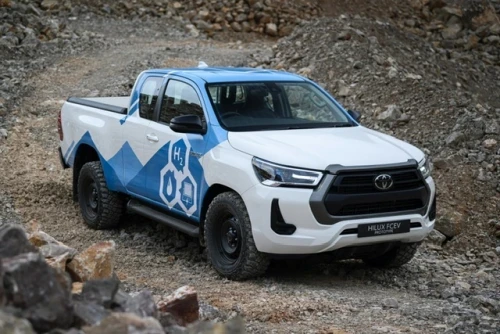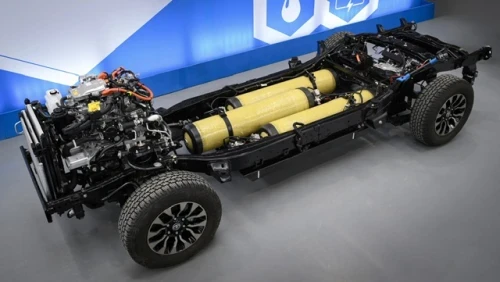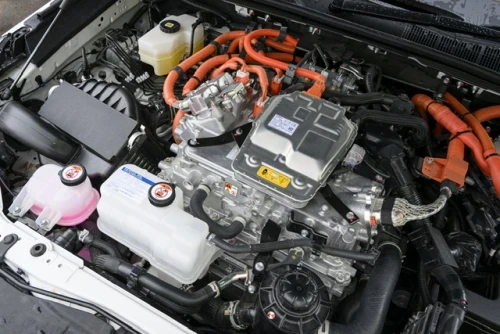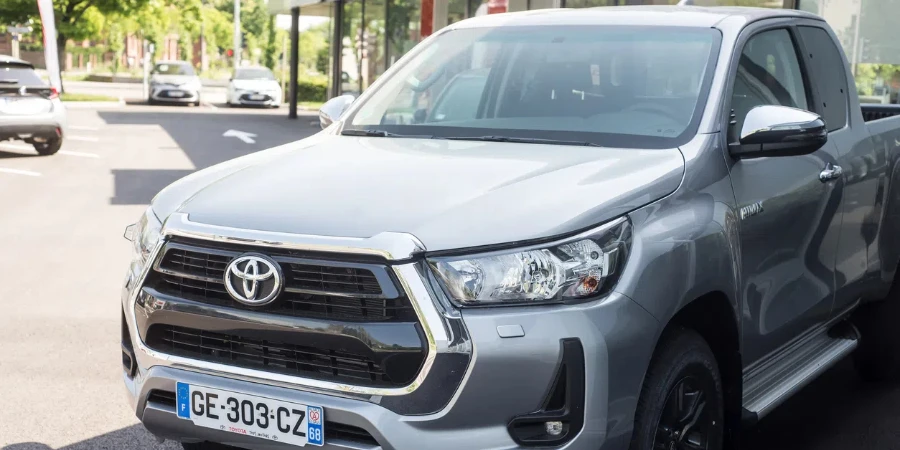A project to realise a hydrogen fuel cell Toyota Hilux pick-up (earlier post) has moved into its next and final phase. Since the unveiling of the first prototype vehicle in September 2023, Toyota and its consortium partners, supported by UK Government funding, have reached an intensive evaluation and demonstration stage.

The latest landmark in this joint development project further demonstrates the broad scope of Toyota’s multi-path strategy towards carbon neutrality, applying different powertrain solutions—hybrid electric, plug-in hybrid electric, battery electric, fuel cell electric and e-fuels—to suit different user needs and local infrastructure.
A total of 10 fuel cell Hilux prototypes have now been built at the Toyota Motor Manufacturing UK (TMUK) facility in Derby, England. Five vehicles are undergoing field testing to assess safety, performance, functionality, and durability, generating test drive data in real-world situations.
Five further units are engaged in customer and media demonstrations, including at the forthcoming Olympic and Paralympic Games Paris 2024.
Along with Toyota’s 30 years of research and development into hydrogen fuel cells, know-how from the Hilux project will contribute to the next generation of fuel cell technology, which will offer longer lifecycles, increased driving range for vehicles and significantly reduced costs.

Toyota expects Europe to be one of the largest hydrogen fuel cell markets by 2030, with steady growth in mobility and power generation applications. As a result, in December 2023 Toyota Motor Europe (TME) announced the Hydrogen Factory Europe, representing Toyota’s co-ordinated approach to the commerciali ation of this technology, from development and production to sales and aftersales.
The fuel cell Hilux prototype project is an important stepping stone to further develop hydrogen technology and stimulate a wider roll-out of hydrogen eco-systems and infrastructure across Europe, Toyota said.

Vehicle profile. Since its initial launch in 1968, the Hilux has proved its invincibility time and again, having conquered the North Pole, Icelandic volcanoes and the Antarctic continent, while also achieving three victories in the Dakar Rally. The fuel cell Hilux retains that uncompromising DNA while looking to a zero-carbon future.
Externally, the fuel cell Hilux retains the same dimensions and rugged appearance as the latest Hilux. In extra-cab format, it is 5325 mm long, 1855 mm wide and 1810 mm tall but beneath the surface, Toyota’s fuel cell technology marks it out as a trailblazer.
Power is delivered using core elements from the Toyota Mirai—technology that has proved its quality in almost a decade of commercial production since Toyota introduced the mass-produced hydrogen fuel cell sedan in 2015.
The fuel cell Hilux has an expected driving range of up to 600 km—further than might be achieved with a battery electric system. Meanwhile, due to hydrogen’s light weight, a higher payload and towing capability can be achieved compared to other zero-emission alternatives.
Hydrogen is stored in three high-pressure fuel tanks, each containing 2.6 kg for a total system capacity of 7.8 kg. The tanks are mounted within the ladder frame chassis.
The polymer electrolyte fuel cell stack contains 330 cells and is mounted above the front axle. The fuel cell Hilux is rear-wheel drive via an e-motor on the rear axle which delivers 134 kW (182 DIN hp) of maximum power and 300 N·m maximum torque.
A Lithium-ion hybrid battery, which stores the electricity produced on-board by the fuel cell, is positioned in the rear load deck, above the hydrogen tanks. This avoids any loss of cabin space.
Project overview. Starting with a feasibility study in early 2022 to demonstrate the advantages of hydrogen via a representative prototype vehicle, the hydrogen fuel cell Hilux prototype project has moved forwards at pace towards its concluding phase.
The feasibility study, undertaken by TMUK and TME, enabled subsequent funding from the UK Government through the Advanced Propulsion Centre, a non-profit organisation supporting the development of cleaner technologies and new mobility concepts.
A design and development program ran from July 2022 to January 2023, alongside consortium partners Ricardo, ETL, D2H Advanced Technologies, Thatcham Research and with additional support from Toyota Motor Corporation.
Parts manufacturing, including chassis frame welding, took place between February and May 2023, prior to prototype construction, which followed Toyota Production System principles in a dedicated area within the TMUK facility. Ricardo supported preparations for the prototype build, carrying out design and development tasks and confirming the complete manufacturing process in parallel with teams at TMUK.
Prototype construction took place between June and July 2023 and the first vehicle was completed in just three weeks. A further nine prototypes were assembled prior to a thorough evaluation phase from July to December last year, including test rig and track testing.
Those ten prototypes are now undergoing field testing alongside customer engagement activities, which will conclude the final phase of this research and demonstration project for the fuel cell Hilux.
Source from Green Car Congress
Disclaimer: The information set forth above is provided by greencarcongress.com independently of Alibaba.com. Alibaba.com makes no representation and warranties as to the quality and reliability of the seller and products.




